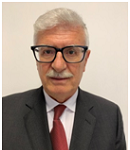
Plenary Lecture
Coastline Erosion and Bed Evolution Induced by Wave Trains and Currents in Nearshore Regions

Professor Francesco Gallerano
Department of Civil, Constructional and Environmental Engineering
"La Sapienza" University of Rome
Italy
E-mail: francesco.gallerano@uniroma1.it
Abstract: In the design of coastal structures, long-term bed evolution predictions play a key role. Bed evolution dynamics is mainly related to wave refraction, shoaling, diffraction, reflection, wave breaking phenomena, to long-shore and rip currents, to the hydrodynamic fields, and wave run-up and run-down phenomena in the swash zone. In the first part of this lecture, a discussion over the phenomena related to coastline erosion and bed evolution, from a qualitative point of view, is presented. The most used models present in literature for the bed evolution in coastal environment, will be discussed in the second part of this lecture. In literature, the simulation of bed morphological change phenomena, is generally performed by a first model for the simulation of the hydrodynamic quantities and a second model for the simulation of the sediment particle resuspension, settling and transport and of the bed morphological change. In the context of the first class of models for the prediction of the hydrodynamics quantities, simulations are often performed in literature by representing the current circulations in terms of two-dimensional flows in the horizontal plane obtained by a depth-average operation of the three-dimensional motion equations. A further development in the two-dimensional hydrodynamic models is represented by two-dimensional phase-resolving models that explicitly represent the periodicity of the wave motion and are based on the Boussinesq equations, which arise from the depth integration of the Euler equations once the depth dependence of the variables is known. More recent models avoid the depth averaging and solve directly the three dimensional motion equations. One of the most challenging issues in the aforementioned models for free surface flows, is surface tracking. Volume of Fluid (VOF) technique is one of the most employed methods used to locate free surface. In a more recent class of 3D models, the time-varying vertical coordinate is mapped into a fixed σ-coordinate. In these models, the kinematic and zero-pressure conditions at the free surface are assigned precisely, given the fact that the free surface position is at the upper computational boundary. Shock-capturing schemes permit an explicit simulation of the wave breaking phenomenon, thus these schemes do not require any empirical calibration. Furthermore the above-mentioned shock-capturing schemes for the solution of motion equations are able to effectively calculate the hydrodynamic quantities in the surf zone and in the swash zone. The second class of models, for the prediction of the sediment particle resuspension, settling and tranport and for the simulation of the bed evolution dynamics, solve the advection-diffusion equation for the suspended sediment concentration. These models take into account the pick-up rate, sediment deposition rate, sediment convection and diffusion. An application of some of the presented models will be shown, regarding the bed evolution produced by the interactions between coastal structures and wave trains and wave-induced currents, in Pescara harbour.
Brief Biography of the Speaker: Francesco Gallerano is Full Professor in Hydraulics at the University of Rome “La Sapienza” since 2000. From 2000 to 2006, he was the President of the Council of the Master’s Degree Course in Environmental Engineering. He is currently the Director of the Ph.D. School of Civil Engineering and Architecture and the Coordinator of the Ph.D. Course in Environmental and Hydraulic Engineering. Since 2017, he is member of the Superior Council of Public Works, for the Italian Government. In the past years, his main research interests were, among the others: diffusion of pollutant in sea; the eutrophication phenomenon in lakes and lagoons; dynamic models for the turbulent sub-grid stress tensor in Large Eddy Simulation. In the last ten years, he dedicated himself to the study of the bed and coastline erosion induced by waves and currents and to the study of high-order numerical models for the simulation of flows in complex geometries. He is author of more than 100 publications at international level and he serves on the Editorial Boards of several International Journals.